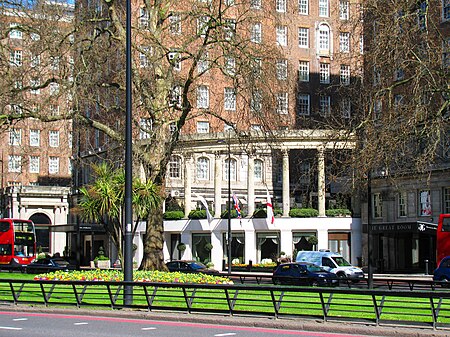Park Lane is a dual carriageway road in the City of Westminster in Central London. It is part of the London Inner Ring Road and runs from Hyde Park Corner in the south to Marble Arch in the north. It separates Hyde Park to the west from Mayfair to the east. The road has a number of historically important properties and hotels and has been one of the most sought after streets in London, despite being a major traffic thoroughfare.
The road was originally a simple country lane on the boundary of Hyde Park, separated by a brick wall. Aristocratic properties appeared during the late 18th century, including Breadalbane House, Somerset House, and Londonderry House. The road grew in popularity during the 19th century after improvements to Hyde Park Corner and more affordable views of the park, which attracted the nouveau riche to the street and led to it becoming one of the most fashionable roads to live on in London. Notable residents included the 1st Duke of Westminster's residence at Grosvenor House, the Dukes of Somerset at Somerset House, and the British prime minister Benjamin Disraeli at No. 93. Other historic properties include Dorchester House, Brook House and Dudley House. In the 20th century, Park Lane became well known for its luxury hotels, particularly The Dorchester, completed in 1931, which became closely associated with eminent writers and international film stars. Flats and shops began appearing on the road, including penthouse flats. Several buildings suffered damage during World War II, yet the road still attracted significant development, including the Park Lane Hotel and the London Hilton on Park Lane, and several sports car garages. A number of properties on the road today are owned by some of the wealthiest businessmen from the Middle East and Asia. Current residents include business mogul Mohamed Al-Fayed and former council leader and Lord Mayor Shirley Porter.
The road has suffered from traffic congestion since the mid-19th century. Various road enlargement schemes have taken place since then, including a major reconstruction programme in the early 1960s that transformed the road into a three-lane dual carriageway by removing a 20-acre (8.1 ha) section of Hyde Park. Improved crossings for cyclists appeared in the early 21st century. Despite the changes, property prices along the road are still among the highest in London. Its prestigious status has been commemorated by being the second-most expensive property square on the London Monopoly board.











